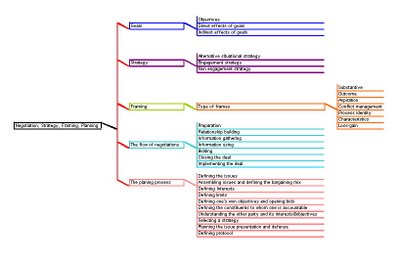
Chapter 2
- Wishes are not goals.
- Our goals are often linked to the other party's goals.
- There are limit to what our goals can be.
- Effective goals must be concrete/specific.
Indirect effects:
- Forging an ongoing relationship.
Strategy is the overall plan to acheive one's goals in a negotiation. Tactics are short-term, adaptive moves designed to enact or pursue broad strategy. Tactics are subordinate to and driven by the strategy. Planning is the action component of the strategy process.
Per Dual Concerns Model is the option of the strategy which is reflected in the answers to two questions: How much concern do I have in achieving the outcomes at stake in the negotiation? and How much concern do I have for the current and future quality of the relationship with the other party?
Relational outcome important? Substantive outcome important?
No No = Avoidance
No Yes = Competition
Yes Yes = Collaboration
Yes No = Accommodation
Framing is about focusing, shaping and organizing the world around us. They frame people, events and processed differently because people have different backgrounds, experiences, expectations and needs.
Frames are critical because:
- Negotiators who understand framing may understand how to have more control over the negotiation process.
- Frames maybe malleable and can be shaped or reshaped during negotiation.
- Frames shift and change as the negotiation evolves.
Frames as categories of experiances:
- Substantive
- Outcome
- Aspiration
- Conflict Management Process
- Identity
- Characterization
- Loss-Gain
Negotiators can use more than one frame. Mismatches in frames between parties are source of conflict. Particular types of frames may lead to particular types of agreements and likely to be used with certain types of issues. Parties may use different frames (Interests, Rights, Power) since there are value differences.
Planning is one of the steps to implement the strategy. Starting from assembling and defining the issues and your interests. You have to know your limits and alternatives, set targets and openings, assess own constituents, analyze the other party, know what strategy and how you want to present and also the protocols need to be followed in this negotiation.